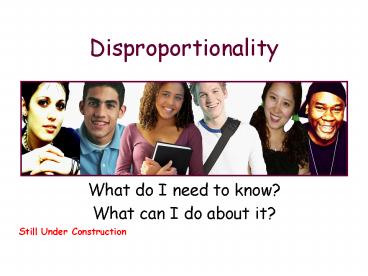Disproportionality - PowerPoint PPT Presentation
1 / 8
Title:
Disproportionality
Description:
are identified at a much higher rate as having a learning disability. ... and while Gay, Lesbian, Bisexual, Transgender and Questioning youth make up only ... – PowerPoint PPT presentation
Number of Views:34
Avg rating:3.0/5.0
Title: Disproportionality
1
Disproportionality
- What do I need to know?
- What can I do about it?
Still Under Construction
2
Youth at Risk
3
Minority Youth
comprise an unequal share of children who
repeat a grade. are far more likely to have
an IEP.
are identified at a much higher rate as having a
learning disability. are over represented
disproportionately in the Child Welfare, Juvenile
and Court Systems.
4
Accumulated Disadvantage
From 2002 to 2004, African Americans were 16
of youth. 28 of juvenile arrests. 30 of
referrals to juvenile court. 37 of the
detained population. 34 of youth formally
processed by the juvenile court. 30 of
adjudicated youth. 35 of youth judicially
waived to criminal court. 38 of youth in
residential placement. 58 of youth admitted to
state adult prison.
5
Incarceration in Adult Prisons
- In 2002, an estimated 4,100 new admissions to
adult prisons involved youth under the age of 18.
3 out of 4 of these youths were youth of color - African American youth accounted for 58 of total
admission to adult prisons - Overrepresentation of youth of color and under
representation of White youth were reported by
nearly every state reporting admissions of youth
under the age of 18 to adult prisons
6
- In 2003, the homeless population was estimated
to be - 49 African-American
- 35 White
- 13 Hispanic
- 2 Native-American
- 1 Asian-American
and while Gay, Lesbian, Bisexual, Transgender
and Questioning youth make up only 10-15 of the
Foster Care population they comprise
approximately 20-42 of homeless youth
7
What can we do about it?
- Dont get defensive or deny the facts now you
know and knowing is half the battle. - Provide culturally responsive services
- Dont apply simplistic solutions
disproportionality is complex and interactive
it isnt just a numbers game. - Need to increase resources available to minority
youth and simplify access to those resources.
8
Self Reflection
- What will stick with you today?
- How will knowing this information help you in
providing services to youth?































